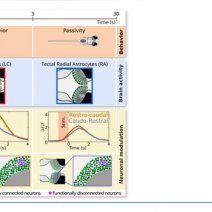Radial astrocyte synchronization modulates the visual system during behavioral-state transitions
A. Uribe-Arias, R. Rozenblat, E. Vinepinsky, E. Marachlian, A. Kulkarni, D. Zada, M. Privat, D. Topsakalian, S. Charpy, V. Candat, S. Nourin, L. Appelbaum, G. Sumbre
Authors :
Alejandro Uribe-Arias1, Rotem Rozenblat2,3, Ehud Vinepinsky1,3, Emiliano Marachlian1,3, Anirudh Kulkarni1, David Zada2, Martin Privat1, Diego Topsakalian1, Sarah Charpy1, Virginie Candat1, Sarah Nourin1, Lior Appelbaum2, Germán Sumbre1,4,5,*
1 Institut de Biologie de l’ENS (IBENS), Département de biologie, École normale supérieure, CNRS, INSERM, Université PSL, 75005 Paris, France.
2 The Faculty of Life Sciences and The Multidisciplinary Brain Research Center. Bar-Ilan University, Ramat-Gan, Israel.
Abstract
Glial cells support the function of neurons. Recent evidence shows that astrocytes are also involved in brain computations. To explore whether and how their excitable nature affects brain computations and motor behaviors, we used two-photon Ca2+ imaging of zebrafish larvae expressing GCaMP in both neurons and Radial Astrocytes (RAs). We found that, in the optic tectum, RAs synchronize their Ca2+ transients immediately after the end of an escape behavior. Using optogenetics, ablations and a genetically encoded norepinephrine sensor we observed that RA synchronous Ca2+ events are mediated by the locus-coeruleus-norepinephrine circuit. RA synchronization did not induce direct excitation or inhibition of tectal neurons. Nevertheless, it modulated the direction selectivity and the long-distance functional correlations among neurons. This mechanism supports freezing behavior following a switch to an alerted state. These results show that LC-mediated neuro-glia interactions modulate the visual system during transitions between behavioral states.
Neuron 2023 Oct 19 ; doi.org/10.1016/j.neuron.2023.09.022


